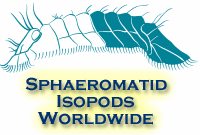| Abstract |
Based on collections mainly from Antarctica and Patagonia new characters of taxonomic importance are discussed, namely the setation of pereopods, the shape and position of uropods,the shape of the fourth pleopod, sexual dimorphisms of pereopods and pleopod 2.With the help of these characters all known genera are divided into related groups of genera. The new genera Atlantoserolis, Brazilserolis, Caecoserolis, Neoserolis, Paraserolis, and Septemserolis are proposed, a checklist of all known species of the family is included. Comparing the phylogeny of serolid taxa with their geographical distribution it appears that since the final breakup of Gondwana evolution took place in three separate centres of radiation (South America, Antarctica, Australia). The origin and dispersal of deep-sea taxa of the Atlantic Ocean and of the Southern Ocean is discussed. A Gondwana relict region with elements derived from an ancient Cretaceous fauna is identified at the southern shores of the southern continents.>
{IAtlantoserolis} n.gen., {IBrazilserolis} n.gen., {ICaecoserolis} n.gen., {INeoserolis} n.gen., {IParaserolis} n.sp., {ISeptemserolis} n.sp.
ANIMAL DISTRIBUTION; ANTARCTICA; ATLANTOSEROLIS; BRAZILSEROLIS; CAECIJAERA; ECOLOGY; EVOLUTION; ISOPODA; MALACOSTRACA; MORPHOLOGY; NEOSEROLIS EXIGUA NEW GENUS NEW COMBINATION; PARASEROLIS; PHYLOGENY; RESEARCH ARTICLE; SEPTEMSEROLIS SEPTEMCARINATA NEW GENUS NEW COMBINATION; SEROLIDAE; SEXUAL POLYMORPHISM; SOUTH AMERICA; TAXONOMY |

















